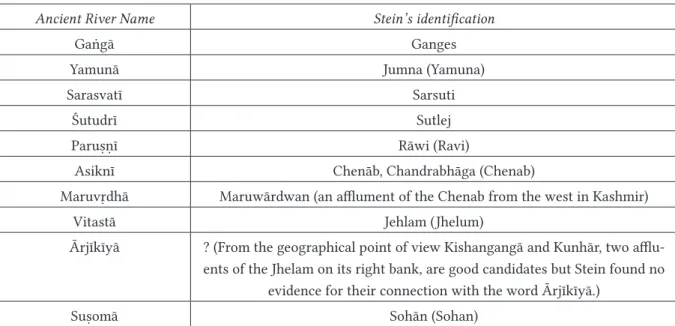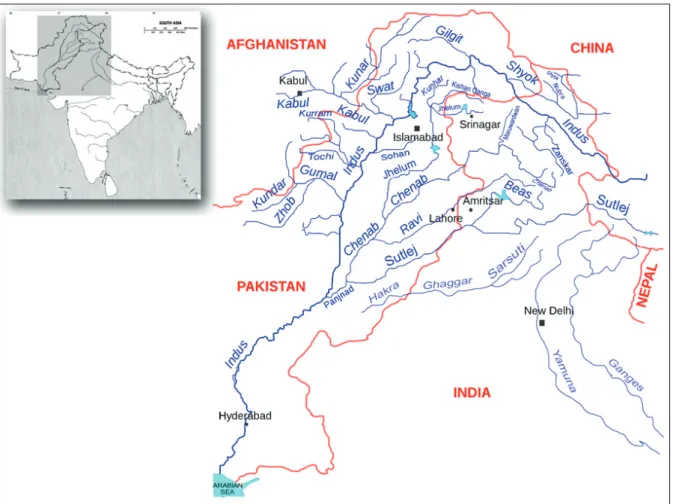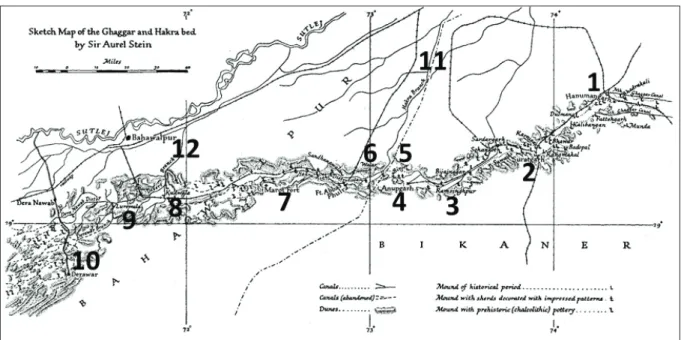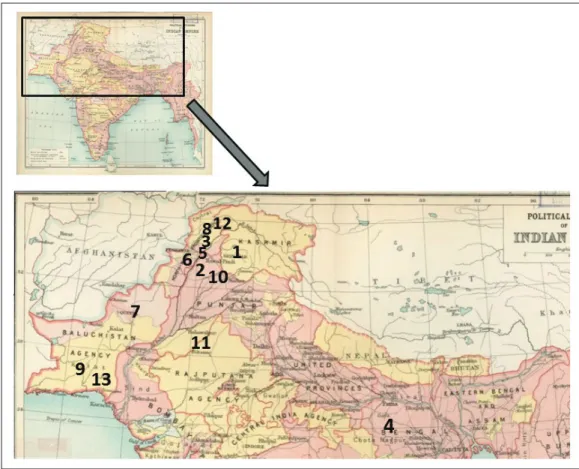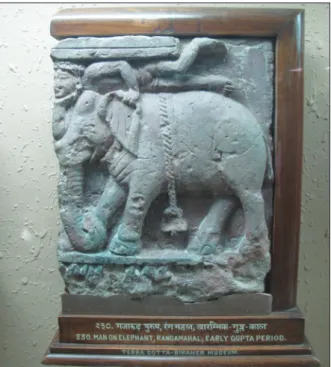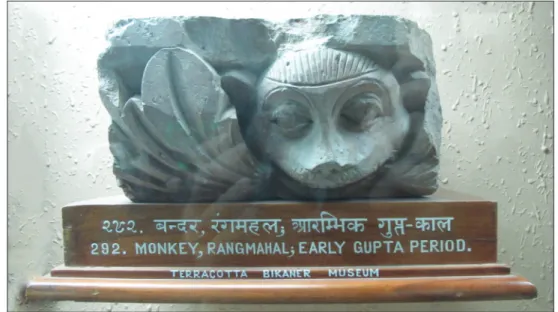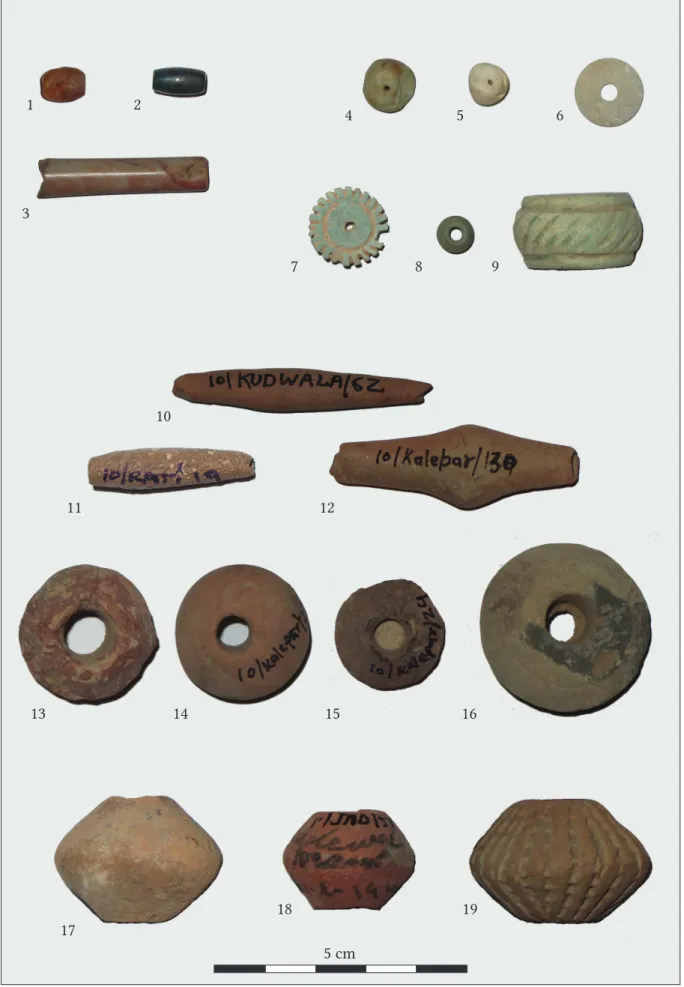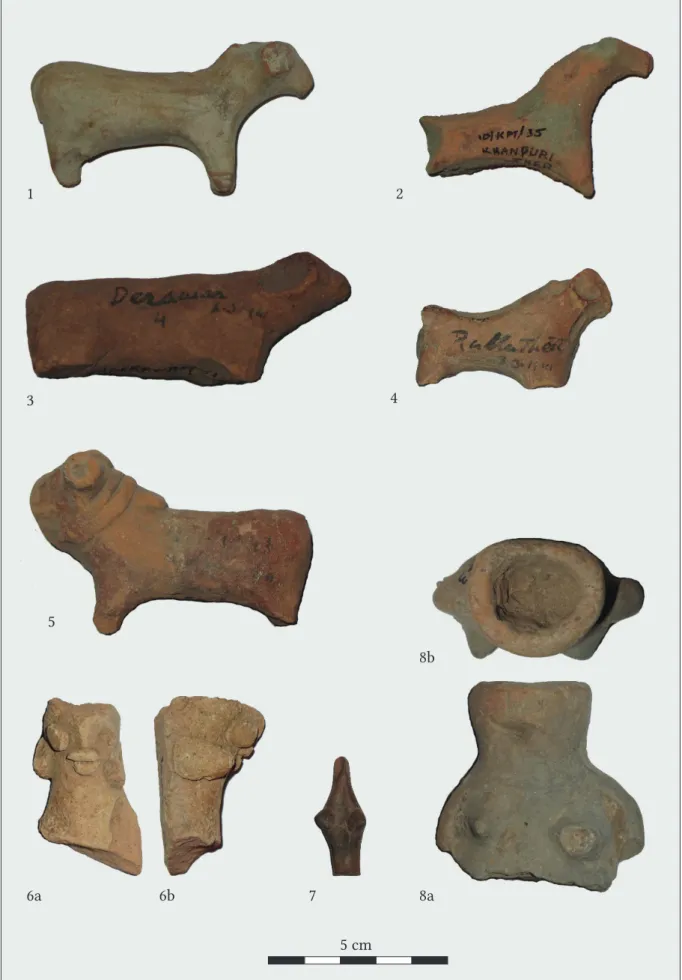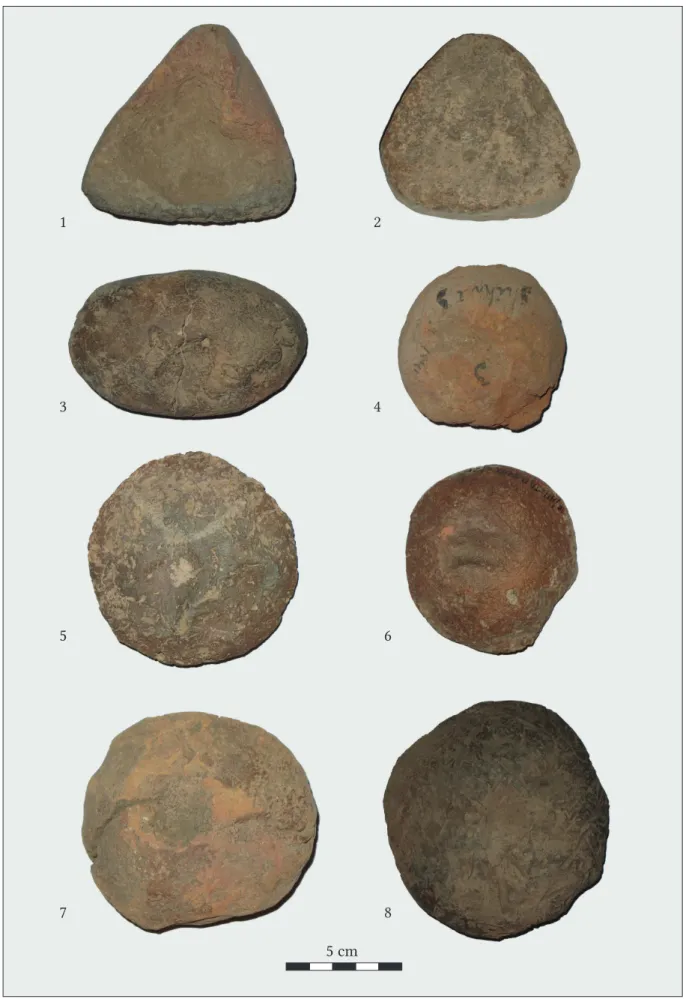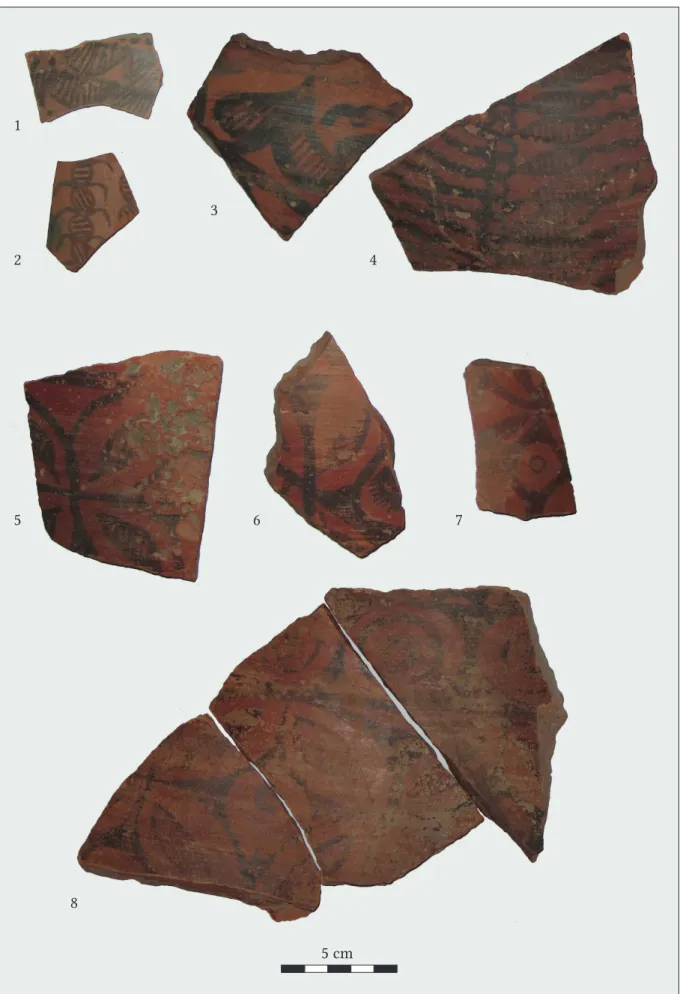Ser. 3. No. 6. 2018 |
ex Instituto Archaeologico Universitatis de Rolando Eötvös nominatae
DISSERT A TIONES ARCHAEOLO GICAE
Arch Diss 2018 3.6
D IS S E R T A T IO N E S A R C H A E O L O G IC A E
Dissertationes Archaeologicae
ex Instituto Archaeologico
Universitatis de Rolando Eötvös nominatae Ser. 3. No. 6.
Budapest 2018
Dissertationes Archaeologicae ex Instituto Archaeologico Universitatis de Rolando Eötvös nominatae
Ser. 3. No. 6.
Editor-in-chief:
Dávid Bartus Editorial board:
László BartosieWicz László Borhy Zoltán Czajlik
István Feld Gábor Kalla
Pál Raczky Miklós Szabó Tivadar Vida
Technical editor:
Gábor Váczi Proofreading:
ZsóFia KondÉ Szilvia Bartus-Szöllősi
Aviable online at htt p://dissarch.elte.hu Contact: dissarch@btk.elte.hu
© Eötvös Loránd University, Institute of Archaeological Sciences Layout and cover design: Gábor Váczi
Budapest 2018
Contents
Zsolt Mester 9
In memoriam Jacques Tixier (1925–2018)
Articles
Katalin Sebők 13
On the possibilities of interpreting Neolithic pottery – Az újkőkori kerámia értelmezési lehetőségeiről
András Füzesi – Pál Raczky 43
Öcsöd-Kováshalom. Potscape of a Late Neolithic site in the Tisza region
Katalin Sebők – Norbert Faragó 147
Theory into practice: basic connections and stylistic affiliations of the Late Neolithic settlement at Pusztataskony-Ledence 1
Eszter Solnay 179
Early Copper Age Graves from Polgár-Nagy-Kasziba
László Gucsi – Nóra Szabó 217
Examination and possible interpretations of a Middle Bronze Age structured deposition
Kristóf Fülöp 287
Why is it so rare and random to find pyre sites? Two cremation experiments to understand the characteristics of pyre sites and their investigational possibilities
Gábor János Tarbay 313
“Looted Warriors” from Eastern Europe
Péter Mogyorós 361
Pre-Scythian burial in Tiszakürt
Szilvia Joháczi 371
A New Method in the Attribution? Attempts of the Employment of Geometric Morphometrics in the Attribution of Late Archaic Attic Lekythoi
Anita Benes 419 The Roman aqueduct of Brigetio
Lajos Juhász 441
A republican plated denarius from Aquincum
Barbara Hajdu 445
Terra sigillata from the territory of the civil town of Brigetio
Krisztina Hoppál – István Vida – Shinatria Adhityatama – Lu Yahui 461
‘All that glitters is not Roman’. Roman coins discovered in East Java, Indonesia.
A study on new data with an overview on other coins discovered beyond India
Field Reports
Zsolt Mester – Ferenc Cserpák – Norbert Faragó 493
Preliminary report on the excavation at Andornaktálya-Marinka in 2018
Kristóf Fülöp – Denisa M. Lönhardt – Nóra Szabó – Gábor Váczi 499 Preliminary report on the excavation of the site Tiszakürt-Zsilke-tanya
Bence Simon – Szilvia Joháczi – Zita Kis 515
Short report on a rescue excavation of a prehistoric and Árpádian Age site near Tura (Pest County, Hungary)
Zoltán Czajlik – Katalin Novinszki-Groma – László Rupnik – András Bödőcs – et al. 527 Archaeological investigations on the Süttő plateau in 2018
Dávid Bartus – László Borhy – Szilvia Joháczi – Emese Számadó 541 Short report on the excavations in the legionary fortress of Brigetio (2017–2018)
Bence Simon – Szilvia Joháczi 549
Short report on the rescue excavations in the Roman Age Barbaricum near Abony (Pest County, Hungary)
Szabolcs Balázs Nagy 557
Recent excavations at the medieval castle of Bánd
Thesis Abstracts
Rita Jeney 573
Lost Collection from a Lost River: Interpreting Sir Aurel Stein’s “Sarasvatī Tour”
in the History of South Asian Archaeology
István Vida 591
The Chronology of the Marcomannic-Sarmatian wars. The Danubian wars of Marcus Aurelius in the light of numismatics
Zsófia Masek 597
Settlement History of the Middle Tisza Region in the 4th–6th centuries AD.
According to the Evaluation of the Material from Rákóczifalva-Bagi-földek 5–8–8A sites
Alpár Dobos 621
Transformations of the human communities in the eastern part of the Carpathian Basin between the middle of the 5th and 7th century. Row-grave cemeteries in Transylvania, Partium and Banat
DissArch Ser. 3. No. 6. (2018) 573–590. DOI: 10.17204/dissarch.2018.573
Lost Collection from a Lost River:
Interpreting Sir Aurel Stein’s “Sarasvatī Tour”
in the History of South Asian Archaeology
Rita Jeney
Bhaktivedanta College rita.jeney@gmail.com
Abstract
Abstract of PhD thesis submitted in 2018 to the Atelier Doctoral Programme, Doctoral School of History, Eötvös Loránd University, Budapest, under the supervision of Gábor Sonkoly, in co-operation with Deccan College Post Graduate and Research Institute, Pune, India, under the supervision of Vasant Shinde.
Topic and aims of the dissertation
One of the central questions of my dissertation is the unique role of Sir Aurel Stein (1862–
1943) in the history of South Asian archaeology. The Hungarian born explorer obtained world-fame with his archaeological discoveries on the Silk Road, and in Indian studies he is well-known as the translator of the Sanskrit historical text, Rājataraṅgiṇī. However, his archaeological activities within the borders of British India are less known and discussed even in the academic literature, despite the fact that from 1904 for almost four decades he was associated with the Archaeological Survey of India (ASI). This lacuna inspired me to examine how the Sanskritist born in Hungary became first a part-time, then a full-time ar- chaeologist at the ASI, and what kind of expeditions he led in India from his arrival (1888) until the last year of his life (1943).
Among these expeditions his “survey of ancient sites along the ’lost’ Sarasvatī River”, as he called his own tour in The Geographical Journal,1 deserves special attention. This was one of his last tours, led for two winter seasons between 1940 and 1943 when he was eighty years old. The Sanskrit word ‘Sarasvatī’ basically refers to two things: a river and a goddess.
Etymologically the word means “a region abounding in pools and lakes” in a feminine form, as all the goddesses and rivers are.2 It appears in all the important ancient Indian texts.3 Although this sacred river was preserved in the Hindu religious memory, no geographical proof was known of its actual existence in South Asia, and therefore it was considered a mythical river. The discrepancy between the ancient texts and the current geographical fea- tures inspired researchers prior to Aurel Stein to locate the “lost” river Sarasvatī; however, Stein was the first approaching the question with interdisciplinary methods, involving the means of philology, geography and archaeology.
1 Stein 1942.
2 Monier-Williams 2002, 1182. Saras refers to “a large sheet of water” and the affix -vat adds the meaning
“abounding in” or “connected with”.
3 See an overview in Söhnen-Thieme 2009, 726–728.
574
Rita Jeney
The textual basis of Stein’s research was a famous hymn from the Ṛg-veda (X.75), called Nadī-stuti or Song of Rivers. By etymologically analysing the names of the rivers listed in the fifth stanza of this hymn and examining maps prepared by the Survey of India, Stein identified the ancient river names with contemporary ones of northwest India with only one exception (Fig. 1–2). He concluded that the hymn lists the rivers from east to west in geographical order.4
Ancient River Name Stein’s identification
Gaṅgā Ganges
Yamunā Jumna (Yamuna)
Sarasvatī Sarsuti
Śutudrī Sutlej
Paruṣṇī Rāwi (Ravi)
Asiknī Chenāb, Chandrabhāga (Chenab)
Maruvṛdhā Maruwārdwan (an afflument of the Chenab from the west in Kashmir)
Vitastā Jehlam (Jhelum)
Ārjīkīyā ? (From the geographical point of view Kishangangā and Kunhār, two afflu- ents of the Jhelam on its right bank, are good candidates but Stein found no
evidence for their connection with the word Ārjīkīyā.)
Suṣomā Sohān (Sohan)
However, whereas numerous hymns in the Ṛg-veda describe the Sarasvatī as a large river,5 its present equivalent, called Sarsuti, is only a periodic stream. To solve this contradiction, Stein surveyed the actual geographical area, and during the winter season of 1940–41 he explored almost 400 km along the dry river bed, between Hanumangarh in Bikaner and Derawar in Bahawalpur.6 Surveyor Muhammad Ayub Khan from the Survey of India assisted him in top- ographical observations, and with Khan’s help Stein published the sketch map of the whole region (Fig. 3). Stein set the following goals:
• understanding the period when the river’s water permitted continuous agriculture;
• understanding the chronology of the process which led to water ceasing to flow in the bed;
• collecting new data for the desiccation problem of Asia;7
• collecting reliable records for the study of early Indian history.8
Based on surface formations of the river bed Stein concluded that the ancient river was much more significant in the past, and therefore could be identified with the abundant Sarasvatī River mentioned in the Ṛg-veda.9
4 Stein 1917, 98.
5 See the list of hymns in Macdonell – Keith 1912, 435.
6 The modern name of the river in Bikaner is Ghaggar, whereas in Bahawalpur it is Hakra, and together it is often referred as the Ghaggar-Hakra. See Fig. 2.
7 Stein addressed the problem of desiccation in 1911 in Hungarian (Stein 1911), and later in English also (Stein 1938).
8 Stein 1942, 173.
9 Stein 1942, 182.
Fig. 1. Stein’s analysis of the river names from Ṛg-veda X.75.5 (Stein 1917, 91–99).
575 Interpreting Sir Aurel Stein’s “Sarasvatī Tour” in the History of South Asian Archaeology
During his survey, thus, Stein personally observed the riverine belt over an extended area and gave a topographical interpretation of the surface formations. Moreover, he made a serious attempt to date the occurring changes of the river by the archaeological exploration of the region. Along the river bed he noticed smaller or bigger mounds (locally known as theris and thers respectively),10 which were bare of all vegetation and covered with pieces of broken pottery, due to the erosion of wind and rain. These abandoned sites were easily recognisable and well known by the local people, whereas those on which occupation had been continuous were less detectable.11 Stein collected pottery and other small finds from the surface of the sites and conducted trial excavations on some of them. His assistant from the Archaeological Survey of India was the young but promising archaeologist, Dr. Krishna Deva. By studying the stylistic features of the collected potsherds Stein set the following chronological frame for the river’s drying up: He concluded that the lower part of the Hakra (between Walar and Derawar), due to the changes in the course of the Sutlej, dried up some time in the early third millennium B.C., causing the abandonment of settlements during prehistoric times. However, the upper part, called Ghaggar (between Hanumangarh and Anupgarh), continued to exist, and its floods made agriculture possible even in the early historic period (1st–3rd century A.D.).
Then the drying up was gradual, caused probably by diversion of flood water for irrigation.12
10 Stein defined the notion as follows: “mounds marking village sites which have been abandoned as no longer supporting an agricultural population” (Stein 1989, 27).
11 Stein 1942, 176.
12 Stein 1942, 177–182.
Fig. 2. Modern rivers of northwest India and Pakistan.
576
Rita Jeney
The area of Stein’s research was divided just a few years after his survey, during the parti- tion of India in 1947, and therefore he was the last researcher examining the region as one geographical unit. Since then the directions of research have been completely separated be- tween Pakistan and India. Stein’s survey and its results, thus, have a special importance in the history of South Asian archaeology, as well as in Vedic studies concerning the date and authorship of the Ṛg-veda. However, in spite of its importance, the tour has never been fully published. My goal in the dissertation, therefore, was to draw a complete picture of the histo- ry and results of the Sarasvatī tour based on published and unpublished sources.
Among the published sources only one appeared during Aurel Stein’s life: a shorter report in the columns of The Geographical Journal in 1942.13 However, four decades after his death the text of his detailed report was also published.14 Nevertheless, his original illustrations and the actual artefacts collected by him were generally considered lost, and thus the archaeological aspect of his work remained inaccessible. In order to bring new sources of evidence into the academic discussion I visited different institutions in India, England and Hungary, as the lega- cy of Aurel Stein is scattered mainly among these countries. As a result, I widened the sources of information regarding Stein’s Sarasvatī tour with the following categories:
• notebooks, manuscripts and letters of Aurel Stein;
• photographs taken by Aurel Stein;
• artefacts collected by Aurel Stein.
My goal was not only to describe these unpublished sources but also re-examine them and interpret Stein’s terminology and chronological observations in the light of new results in South Asian archaeology.
13 Stein 1942.
14 Stein 1989.
Fig. 3. Sketch Map of the Ghaggar-Hakra tour: 1 – Hanumangarh, 2 – Suratgarh, 3 – Ramsinghpur, 4 – Anupgarh, 5 – Binjor, 6 – Walar, 7 – Marot, 8 – Kudwala, 9 – Lurewala, 10 – Derawar, 11 – Hakra Branch, 12 – Desert Branch (Stein 1942, 174).
577 Interpreting Sir Aurel Stein’s “Sarasvatī Tour” in the History of South Asian Archaeology
Structure and methods of the dissertation
Based on its topic the dissertation can be divided into two parts: Chapter 1 and 2 discusses the context, whereas Chapter 3 and 4 focuses on the Sarasvatī tour itself. In the First Chapter I present a short overview of the institutionalization of Indian archaeology and its main per- sonalities, as by the time of Stein’s arrival, archaeology in India as a discipline had already de- veloped and obtained its institutionalized framework. This institution formed the background of Stein’s archaeological activities, not only within the borders of British India, but in many cases, outside also. Stein’s methods were rooted in the legacy of his predecessors in Indian archaeology, and his dealings with his colleagues often shaped the direction of his research.
The academic literature published on Aurel Stein is also reviewed in this chapter.
In the Second Chapter I present a biography of Aurel Stein’s professional life from the per- spective of Indian archaeology, along with the personal aspects of his choices and goals.
The structure of this chapter is chronological, and it is based primarily on Aurel Stein’s own publications and his biographies. Here I systematically present all of his archaeological ex- peditions led within the borders of British India by answering the following questions: What were the regions he surveyed and why did he choose them? What methods did he use in surveying, documenting and dating? How did he publish his results, and how did he describe the archaeological features and artefacts? And finally, what importance did he attribute to a particular site? As the goal of this chapter is to show the role of Aurel Stein’s expeditions in the history of South Asian archaeology, in each case I examine the future significance of the visited sites, and I present the revisions by later scholars of Stein’s results. This analysis allows me to describe the main characteristics of Aurel Stein as an archaeologist in India and helps me contextualize the one particular expedition I examine in the light of newly discovered sources: the Sarasvatī tour.
The topic of the Third Chapter is the description of the four kinds of sources used in the in- terpretation of the Sarasvatī tour. First the published literature is reviewed, and Stein’s inter- disciplinary approach is presented: incorporating his philological approach, his geographical approach and his archaeological approach. Second, Stein’s handwritten legacy is described:
notebooks, manuscripts and letters in connection to the Sarasvatī tour, housed mainly in the Bodleian Libraries, University of Oxford.15 This material (approx. 2000 pages) includes daily diaries of the surveys and field notebooks, manuscripts of planned publications and Stein’s so-called “Personal Narratives”, and official as well as personal correspondence. Together they allowed me to draw the broader history of the Sarasvatī tour from its preparations until the arrangements for the publication of the results. The third kind of source is the photographs Stein prepared during his expedition, housed in the Library and Information Centre of the Hungarian Academy of Sciences.16 The importance of these pictures is that they show the
“lost” artefacts Stein collected during his Sarasvatī tour arranged by him for a planned pub- lication. The photographs of 24 terracotta reliefs and nearly 300 pottery fragments and other minor objects allowed me to reconstruct the archaeological aspect of Stein’s tour; however,
15 I thank the Bodleian Libraries, University of Oxford, for giving me permission to study Stein’s original manuscripts.
16 I thank the head of department and curator of the Sir Aurel Stein Collection at the Library and Information Centre of the Hungarian Academy of Sciences, Ágnes Kelecsényi, for providing me access to Stein’s photo- graph collection.
578
Rita Jeney
for the re-examination of the finds the study of the original artefacts was required. These ar- tefacts constitute the fourth group of sources. The terracotta reliefs pictured in Stein’s photo- graphs were found in the exhibition of the Ganga Golden Jubilee Museum in Bikaner, whereas the pottery and minor object collection was in the care of the Archaeological Survey of India in Delhi.17 The number of objects in their care exceeds the number in Stein’s photographs.
I documented and analysed more than 1500 objects belonging to Stein’s Sarasvatī expedition.
In the Fourth Chapter I present the interpretation of the Sarasvatī tour by examining the four sources of information together. The different collections of the Sarasvatī tour (housed in different institutions of different countries) do not bear the same information when studied separately rather than together. For example, Stein’s photographs show the artefacts he col- lected, but the names of the sites they are from become clear only from his handwritten notes.
And although the best source for describing Stein’s finds is the original artefacts, when the labels he wrote on them are worn off, the photographs help to identify the objects as part of Stein’s collection. Thus, this methodology, which I call cross-collection comparison, allows a comprehensive interpretation of the Sarasvatī tour.
Results
Sir Aurel Stein: the archaeologist in British India
During Aurel Stein’s archaeological career in India, almost always the northwestern part of the Subcontinent was the centre of his interest (Fig. 4). Here he searched either for the traces of the conquests of Alexander the Great or for the remains of Buddhist pilgrimage sites of ancient Gandhāra. One exception was his tour to South Bihar and Chota Nagpur in 1899.18 Although this may differ in territorial aspect, regarding the studied material, namely Bud- dhist art, it fits into the nature of the northwestern expeditions. Till the 1920s Stein studied historic remains; however, after the discovery of the Harappan Civilization, his interest in prehistoric sites arose. He surveyed a vast area in order to identify settlements belonging to the era of South Asia’s first urbanized cultural complex, and he discovered a large number of sites in Baluchistan and along the dry bed of the Ghaggar-Hakra River. During his archae- ological reconnaissance he primarily focused on exploring hitherto unsurveyed regions and gave a programme for large scale excavations of the discovered sites for generations of future archaeologists. Written sources had a great significance in his research. Whether it be some ancient Sanskrit texts, the descriptions of Chinese pilgrims or Greek historical sources, most of the time they provided the basis for his field research. On his expeditions he compared the descriptions with the actual geography of the area. According to him, the geography of a re- gion has always played a crucial role in the history of its inhabitants, and therefore he usually approached a historical problem from a geographical standpoint.19 In order to confirm his hypotheses, in many cases he was able to etymologically analyse the modern place names and show convincingly how they derived from the names mentioned in the ancient sources. He liked to look for existing local legends or other traces in oral tradition that supported his ar-
17 I thank the Archaeological Survey of India for granting me permission to study its stored archaeological material. This research was supported by the European Union and co-financed by the European Social Fund (grant agreement no. TAMOP 4.2.1/B-09/1/KMR-2010-0003).
18 Stein 1901.
19 Deva 1982, 392.
579 Interpreting Sir Aurel Stein’s “Sarasvatī Tour” in the History of South Asian Archaeology gument. Then, to prove the existence and antiquity of human activity he searched for archae- ological remains. He developed the interdisciplinary method of using text, geography, oral tradition and archaeology during his very first antiquarian tours in Kashmir,20 and practiced it until his last expeditions, such as the Sarasvatī tour. His early interest in protecting cultural heritage is notable, and the accuracy of his results in the light of later research is remarkably high. The number of his publications on the subject of South Asian archaeology exceeds two dozen, among which several are detailed reports and separate monographs.
The Sarasvatī tour
Stein’s survey along the Sarasvatī River fits well into the general characteristics of his expe- ditions. It is a quintessential example of the parallel use of text, geography and archaeology, and the style of the tour also shows his usual method: exploring a large area, collecting main- ly surface finds along with the results of a few trial excavations, and giving a large number of newly discovered sites for future research. However, this tour has several differences. Its topic is not about tracing the conquered places of Alexander the Great, nor about following the descriptions of Chinese pilgrims among the ruins of Buddhist sites. It is about confirming
20 Zutshi 2011, 110.
Fig. 4. Political Divisions of the Indian Empire (Meyer et al. 1909, Vol. 26, 20) showing the regions Aurel Stein explored. 1 – Kashmir (1888–1896), 2 – Salt Range (1889–1890 and 1901), 3 – Swat and Buner (1896–1898), 4 – South Bihar and Chota Nagpur (1899), 5 – Indus (1900), 6 – North-West Fron- tier Province (1904 and 1912), 7 – North Baluchistan (1904 and 1927), 8 – Upper Swat (1926), 9 – South Baluchistan (1928), 10 – Punjab (1931), 11 – Ghaggar-Hakra (1940–1943), 12 – Indus Kohistan (1941), 13 – Las Bela (1943).
580
Rita Jeney
geographically relevant references of the Ṛg-veda. The location of the tour (Rajputana and the eastern part of Punjab) also differs slightly from Stein’s usual expedition areas. Finally, in spite of Stein’s thoroughness in publishing, this tour has not been completely published.
The reconstruction of the broader history of the Sarasvatī tour from Stein’s diaries and letters shows that Stein did complete a detailed report of the tour along with its illustrations for a publication by the Archaeological Survey of India; however, the regulations in publishing dur- ing World War II prevented it from appearing. Then, due to Stein’s death, the publication was not pursued, and the legacy got scattered. In my dissertation, I not only re-join this legacy and give a detailed description of its preserved part, but I make an attempt for its reinterpretation.
The archaeological collection of the Sarasvatī tour
Stein’s rediscovered archaeological collection consists of three main categories of artefacts:
terracotta reliefs, pottery and minor objects, housed in the exhibition of the Ganga Golden Jubilee Museum in Bikaner and in the store-rooms of the Archaeological Survey of India in Delhi. Nevertheless, the collection is not complete. Stein recorded 97 archaeological sites during his survey, but archaeological material is available only from 51 sites in these institu- tions. Moreover, the collection is incomplete even from the sites that have preserved artefacts.
I have no explanation for the uneven distribution of the preserved finds. It is possible that some parts are stored in other institutions, or the rest is simply lost. I am aware of the lim- itations of the conclusion that can be drawn from such data. However, the preserved part of Stein’s “lost” collection is still representative, and its publication contributes not only to the conservation and accessibility of Aurel Stein’s legacy, but also to the preservation of the archaeological heritage of the sites along the Ghaggar-Hakra, among which many are not visible anymore, due to the human and natural causes of site erosion.
In the exhibition of the Ganga Golden Ju- bilee Museum in Bikaner I identified 11 terracotta reliefs that belonged to Stein’s Sarasvatī Tour, based on Stein’s 24 archival photographs in the Library and Informa- tion Centre of the Hungarian Academy of Sciences. These terracottas belong to three categories: panel, frieze and figurine. The panels originally belonged to the facade of buildings. Their design can be human, an- imal, floral or geometric. The friezes have animal, floral or geometric design (Fig. 5–6).
The figurines (mostly showing the head) did not necessarily had an architectural role; they could belong to other objects, like pots, for example. Based on their style, they were dated to the late Kushan, early Gupta age, i.e. between the 3rd and the 5th centuries A.D.21
21 Sant 1997, 171–188.
Fig. 5. Example of terracotta relief panel. Ganga Golden Jubilee Museum, Exhibition No. 230.
581 Interpreting Sir Aurel Stein’s “Sarasvatī Tour” in the History of South Asian Archaeology
At the Archaeological Survey of India in Delhi I documented 1522 artefacts in the preserved collection of Stein’s Sarasvatī tour. The great majority of the documented artefacts are pottery fragments (1226 pieces), whereas the rest are other minor objects (296 pieces). These minor objects include different small tools, ornaments and toys. A common feature of early settle- ments is worked stones such as flints, lithic cores or polished stones. Ornaments include bro- ken pieces of bangles made of terracotta, shell or faience, terracotta rings worn as pendant or other decoration and different beads (Fig. 7). Terracotta figurines (Fig. 8) representing human or animal forms might have served as ritual objects, or they were simply toys, just as the small terracotta models of carts and game pieces used for board games. Some of the terracotta ob- jects such as lids, handles, feeding cups and moulds were categorized as minor objects instead of pottery in order to keep the pottery classification simpler. Other terracotta tools include sling balls and terracotta cakes. Sling balls are special missiles released by means of slings or thrown by hand.22 Terracotta cakes are common in the Harappan assemblage (Fig. 9). These flat objects with triangular, oval or round shape are 4 to 10 cm in size. The round ones usually have a finger impression on their flat surface. Their use is not evident, they might have been served as soling material of roads or floors, or maybe they had some role, even ritualistic, around fire-places.23
As the collection consists mostly of surface finds, age determination of the artefacts was pos- sible on the basis of stylistic features with the help of analogous finds from later excavations.
Among the pottery the two main categories are historic and protohistoric pottery. In the Indi- an subcontinent the historic age starts with the inscriptions of King Aśoka (3rd century B.C.), as these are the first documents that can be used as historical sources.24 The term protohistory was first used in the Indian context by Henry Heras.25 Although it has been a controversial term, in the 1970s H. D. Sankalia defined it as a period between 3500 or 3000 and 300 B.C., in
22 Ghosh 1989, Vol. 1, 187.
23 Ghosh 1989, Vol. 1, 188; Manuel 2009, 41–45.
24 Allchin – Allchin 1968, 27.
25 Sankalia et al. 1973, 512. Henry Heras, Jesuit priest, studied the remains of Harappan Civilization and tried to read its script also. See Possehl 1996, 110–115.
Fig. 6. Example of terracotta relief frieze. Ganga Golden Jubilee Museum, Exhibition No. 292.
582
Rita Jeney
other words, following the Mesolitic cultures, and presiding the Mauryas.26 Similarly, Jerome Jacobson included all cultures in South Asia “from the time of the earliest known pre-Harap- pan pottery marks of roughly 3000 B.C., which are genetically related to the Indus script, until the beginning of known early historic writing about 300 B.C.”.27
The protohistoric pottery discovered at the sites of the Harappan Civilization is referred to as Harappan pottery (Fig. 10), named after the type-site where it was first discovered and identi- fied.28 Harappa was excavated from the 1920s, and a monograph was published by 1940.29 The other main settlement, Mohenjo-daro, was also excavated during this time, and the first results were published by 1931.30 Although initially the ceramic industry of the Harappan Civilization was considered uniform, later research showed its regional differences.31 The most thorough research of the Hakra region in the Cholistan Desert was led by Mohammad Rafique Mughal,32 who divided the Harappan era into four periods: Hakra (between 3500 B.C. and 3100/3000 B.C.), Early Harappan (between 3100/3000 B.C. and 2500 B.C.), Mature Harappan (between 2500 B.C. and 2000/1900 B.C.) and Late Harappan (between 2000/1900 B.C. and 1500 B.C.).
Pottery belonging to the Iron Age in the Ghaggar-Hakra region is called Painted Grey Ware (PGW). Painted Grey Ware pottery was first identified at the site of Ahichchhatra, Uttar Pradesh, and it was published in 1946.33 At the excavations of Hastinapura in the 1950s B. B. Lal classified the site’s second period as PGW, and described its pottery in detail.34 He dated it between 1100 and 800 B.C.35 It was A. Ghosh who identified the PGW pottery in the Ghaggar area and determined its relative chronology as preceding the Rang Mahal culture.36 The typical pottery of PGW is a grey ware produced by reduced fire. It is either undecorated or painted with black. However, PGW sites yielded a great number of associated red ware, which usually has shallow impressed design (Fig. 11).37
The historical pottery of Rajasthan is called Rang Mahal ware (Fig. 12). It was defined by the Swedish archaeologist, Hanna Rydh, after excavating the site of Rang Mahal in Rajasthan between 1952 and 1954. She dated the site to the late Kushan period, between 200 A.D. and 600 A.D.38 A. Ghosh observed the spatial distribution of this pottery type mainly in Rajast- han; however, some decorations are more wide-spread and have parallels in North India (e.g.
Hastinapura) and Gujarat, as far as to the Greco-Bactrian site of Sirkap (Punjab, Pakistan).39 The chronological frame of Rang Mahal culture was revised by Akinori Uesugi in the light of newly excavated material from Farmana (Haryana). The historical pottery excavated from pits overlapping the Harappan deposits are defined as Rang Mahal pottery by Uesugi, based on
26 Sankalia et al. 1973, 515.
27 Jacobson 1979, 474.
28 Shinde et al. 2006, 65.
29 Vats 1940.
30 Marshall 1931.
31 Shinde et al. 2006, 65.
32 Mughal 1997.
33 Ghosh – Panigrahi 1946.
34 Lal 1954–1955, 11–15, 32–50.
35 Lal 1954–1955, 23.
36 Ghosh 1953, 34.
37 Ghosh 1953, 33.
38 Rydh 1959, 178–181.
39 Ghosh 1989, Vol. 2, 369–370.
583 Interpreting Sir Aurel Stein’s “Sarasvatī Tour” in the History of South Asian Archaeology forms, shapes, manufacturing techniques and decorations. The dates of this and some further evidence from the surrounding regions led Uesugi to widen the chronological frame of the Rang Mahal pottery. He stated that although the transition to Rang Mahal pottery may have started in the late Kushan period, it continued into the last centuries of the first millennium.
He proposed the time range from the 4th to the 10th centuries A.D. as the major time-period for the Rang Mahal pottery.40
The parallel examination of Stein’s descriptions of artefacts, the preserved material and later publications allowed me to interpret Stein’s terminology, reconstruct his illustrations and revise his chronology. In his report Stein himself presented a chronology for the discovered sites on the basis of his collected finds.41 Although he gave wide chronological frames, his ac- curacy in determining the relative age of the artefacts is notable, especially if we consider that his survey preceded the archaeological determination of the PGW and Rang Mahal cultures, and the Harappan civilization was known only for two decades. In my dissertation I give an analysis of Stein’s chronological observations in relation with the results of later research, and I point out the agreements and differences.
Presenting the comprehensive study of Sir Aurel Stein’s Sarasvatī tour contributes to the his- tory of archaeology by bringing its results back into the academic discourse. It is also a con- tribution to the studies about the legacy of Sir Aurel Stein conducted in every country which he surveyed, or which holds parts of his collection.
References
Allchin, B. – Allchin F. R. 1968: The Birth of Indian Civilization. India and Pakistan before 500 B.C.
Baltimore.
Deva, K. 1982: Contributions of Aurel Stein and N. G. Majumdar to Research into the Harappan Civilization with a Special Reference to their Methodology. In: Possehl, G. L. (ed.): Harappan Civilization. A Contemporary Perspective. New Delhi, 1st edition, 387–393.
Ghosh, A. 1953: Exploration in Bikaner. East and West 4, 31–34.
Ghosh, A. (ed.) 1989: An Encyclopedia of Indian Archaeology. New Delhi.
Ghosh, A. – Panigrahi, K. C. 1946: The Pottery of Ahichchhatra, District Bareilly, U. P. Ancient India 1, 37–59.
Jacobson, J. 1979: Recent Developments in South Asian Prehistory and Protohistory. Annual Review of Anthropology 8, 467–502.
Lal, B. B. 1954–1955: Excavations at Hastināpura and other Explorations in the Upper Gangā and Sut- lej Basins 1950–52. New Light on the Dark Age between the end of the Harappā Culture and the Early Historical Period. Ancient India 10–11, 5–151.
Macdonell, A. A. – Keith, A. B. 1912: Vedic Index of Names and Subjects. Delhi.
Manuel, J. 2009: The Enigmatic Mushtikas and the Associated Triangular Terracotta Cakes. Some Observations. Ancient Asia 2, 41–46.
Marshall, J. 1931: Mohenjo-Daro and the Indus Civilization. London.
Meyer, W. S. – Burn, R. – Cotton, J. S. – Risley, H. H. 1909: The Imperial Gazetteer of India. Oxford.
Monier-Williams, M. (ed.) 2002: A Sanskrit-English Dictionary. Delhi.
40 Uesugi 2014, 145–146.
41 Stein 1942, 178–182; Stein 1989, 92–94.
584
Rita Jeney
Mughal, M. R. 1997: Ancient Cholistan. Archaeology and Architecture. Rawalpini–Lahore–Karachi.
Possehl, G. L. 1996: Indus Age. The Writing System. Philadelphia.
Rydh, H. 1959: Rang Mahal. The Swedish Archaeological Expedition to India, 1952–1954. Lund.
Sankalia, H. D. – Gupta, S. P. – Allchin, F. R. – Dikshit, K. N. – Ghosh, A. – Ghosh, A. K. – Joshi, M. C. – Joshi, R. V. – Misra, V. N. – Rao, S. R. – Sharma, Y. D. – Sinha, K. K. – Thapar, B. K.
1973: Basis and Terminology of Periodization. In: Agrawal, D. P. – Ghosh, A. (eds.): Radiocar- bon and Indian Archaeology. Bombay, 504–518.
Sant, U. 1997: Terracotta Art of Rajasthan. From Pre-Harappan and Harappan times to Gupta Period.
New Delhi.
Shinde, V. – Sinha Deshpande, S. – Osada, T. – Uno, T. 2006: Basic Issues in Harappan Archaeology.
Some Thoughts. Ancient Asia 1, 63–72.
Söhnen-Thieme, R. 2009: Sarasvatī. In: Jacobsen, K. A. (ed.): Brill’s Encyclopedia of Hinduism. Vol. 1.
Leiden, 725–732.
Stein, A. 1901: Notes on an Archaeological Tour in South Bihar and Hazaribagh. The Indian Antiquary 30, 54–63; 81–97.
Stein, A. 1911: Belső-Ázsia általános kiszáradásának kérdése. Földrajzi Közlemények 39, 60–67.
Stein, A. 1917: On some river names in the Ṛgveda. Journal of the Royal Asiatic Society, 91–99.
Stein, A. 1938: Desiccation in Asia: A Geographical Question in the Light of History. The Hungarian Quarterly 4, 642–654.
Stein, A. 1942: A survey of ancient sites along the “lost” Sarasvati River. The Geographical Journal 99, 173–182.
Stein, A. 1989: An Archaeological Tour along the Ghaggar-Hakra River. In: Gupta, S. P. (ed.): An Ar- chaeological Tour along the Ghaggar-Hakra River by Marc Aurel Stein. Meerut, 1–97.
Uesugi, A. 2014: A Note on the Rang Mahal Pottery. Heritage: Journal of Multidisciplinary Studies in Archaeology 2, 125–151.
Vats, M. S. 1940: Excavations at Harappā. Delhi.
Zutshi, Ch. 2011: Landscapes of the Past: Rajatarangini and Historical Knowledge Production in Late-Nineteenth-Century Kashmir. In: Sengupta, I. – Ali, D. (eds.): Knowledge Production, Pedagogy, and Institutions in Colonial India. New York, 99–121.
585 Interpreting Sir Aurel Stein’s “Sarasvatī Tour” in the History of South Asian Archaeology
Fig. 7. Selection of beads from Stein’s Sarasvatī collection: 1–6 – stone beads, 7–9 – faience beads, 10–19 – terracotta beads.
1 2
3
4 5 6
7 8 9
10
11 12
13 14 15 16
17
18 19
5 cm
586
Rita Jeney
Fig. 8. Selection of terracotta figurines from Stein’s Sarasvatī collection: 1–5 – animal figurines, 6–8 – human figurines.
1 2
3 4
5
6a 6b 7 8a
8b
5 cm
587 Interpreting Sir Aurel Stein’s “Sarasvatī Tour” in the History of South Asian Archaeology
Fig. 9. Selection of terracotta cakes from Stein’s Sarasvatī collection: 1–2 – triangular shape, 3 – oval shape, 4–8 – round shape.
1 2
3 4
5 6
7 8
5 cm
588
Rita Jeney
Fig. 10. Selection of Harappan painted pottery from Stein’s Sarasvatī collection.
5 cm 1
2
3
4
5 6
8
7
589 Interpreting Sir Aurel Stein’s “Sarasvatī Tour” in the History of South Asian Archaeology
Fig. 11. Selection of PGW associated red ware from Stein’s Sarasvatī collection.
5 cm
1 2
3
4 5
6 8 9
7
590
Rita Jeney
Fig. 12. Selection of Rang Mahal painted pottery from Stein’s Sarasvatī collection.
5 cm
1 2 3
4 5
6
8
9
10
11 12
7
